Circular Economy on Islands Lags Due to Low Environmental Awareness
February 17, 2021 – In a video podcast entitled "Energy Transition on the Islands," organized by the Island Movement initiative, participants warned that underdeveloped environmental awareness is one of the main obstacles to implementing the circular economy on islands.
As Hina reports, the deputy mayors of Hvar and Cres warned that citizens are still unaware of the green economy's importance, which makes it challenging to introduce a circular economy on islands.
"The most difficult phase in achieving sustainable development is to explain to ordinary citizens why the energy transition would be a step forward," said Marin Gregorović, deputy mayor of Cres.
The circular economy is a production and consumption model that encourages sharing, borrowing, reuse, repair, recovering, and recycling of products and materials to achieve the product's added value. Such a concept has a positive effect on reducing the amount of waste.
Commenting on the inefficient disposal of waste on the islands, Gregorović noted that "the system is not working well" and that "we have not yet reached the stage of resolving the issue of biowaste disposal."
"Although we have a recycling yard and dual waste management on Cres, and we plan to build a composting plant, the story of the circular economy is still just – a story," said Gregorović.
Kuzman Novak, deputy mayor of Hvar town, added that "the fundamental problem at the national level is waste management."
"We take the garbage bags out of the house, and they are taken away, which we don't see, so we don't think they are our concern anymore. That is the key problem," Novak said, explaining the underdeveloped environmental awareness of citizens.
"When we talk about sustainable development, it's not just about solar power plants and waste management, it's essentially developing an awareness not to be selfish," said Novak.
The new EU Action Plan for the Circular Economy is one of the key elements in achieving climate neutrality, which is a central goal of the European Green Plan. Voting on the new EU circular economy action plan, the European Parliament this month called for additional measures to achieve a carbon-neutral, environmentally sustainable, and fully circular economy by 2050.
To read more about lifestyle in Croatia, follow TCN's dedicated page.
UNESCO Heritage of Croatia - Vis Archipelago UNESCO Global Geopark Croatia
May the 27th, 2019 - taking a closer look at beautiful Vis and its UNESCO heritage.
On the 17th of April, 2019, the UNESCO Executive Board approved the designation of eight new Global Geoparks which demonstrate the diversity of the planet’s geology. Croatia's Vis archipelago got this recognition. This article will take a closer look into some natural heritage from the stunning Vis archipelago.
The Vis archipelago covers the island Vis and the surrounding islands and islets Biševo, Sveti Andrija, Brusnik, Jabuka, and Palagruža. The archipelago is the area that has the oldest and youngest geological formations.
Some parts of the archipelago are made from volcanic rocks while most of the Adriatic islands are made from sedimentary rocks. Sailors and fishermen were always aware of this specific geological area. They knew when they would sail close to volcanic islets of Jabuka and Brusnik as their compass would divert from the north, potentially putting them in danger. Vis island has parts where the foundation is volcanic rock, which created several water springs. These springs created fertile conditions, so it's no wonder the ancient Greeks chose Vis about 2,400 years ago as the place to found their first colony on the Adriatic.
The Vis archipelago is located off the coast of Croatia, and there some of the oldest rocks in the Adriatic sea, formed 220 million years ago, can be found. Sedimentary rocks are the base for most of the Vis archipelago. The origin of these rocks comes from the lithification process of sand, mud, and sea organisms.
The north-eastern region of the archipelago includes large sand deposits formed in the Ice Age which created unique forms and caves. Before the sudden rise of the sea level 12000 years ago, these islands were much larger and extended more than twenty miles. In this extended area called Mala Palagruža, an archaeologist discovered flint quarries that served for the production of early tolls believed to have been made by the islands' first inhabitants.
The Vis archipelago is formed around Vis island and includes a number of nearby uninhabited islets: Ravnik, Budihovac, Veli Paržanj, Mali Paržanj, Greben, Host, Veli Barjak and Mali Barjak and the open sea islands among which the most remote are the island of Palagruža, inhabited only by lighthouse keepers, and the magmatic island of Jabuka, some 30 nautical miles west of Vis. The surface of this maritime area covers almost 6000km2 and also includes Sveti Andrija, Brusnik and the island of Biševo which, is the only inhabited island.
In this area, the largest number of ''monuments of nature'' in Europe can be found – Blue Cave, Monk Seal Cave, the volcanic islets of Jabuka and Brusnik, Stiniva Cove, and the Green Cave on the islet of Ravnik.
The Vis archipelago is a small area, but it boasts a wide range of significant landscapes and protected monuments of nature, some of which attract a lot of visitors.
The Blue Cave
In 1884, the Viennese painter baron Ugen Ransonnet introduced the Blue Cave on the island of Biševo to the world. His discovery marked the beginning of tourism in Dalmatia, and the Blue Cave has since become a must-see tourist spot in the Adriatic. The Blue Cave has been a protected geomorphological monument of nature since 1951. Visitors can go to the cave from Biševo Mezoporat. There are people all over the world visiting this unique cave every summer.
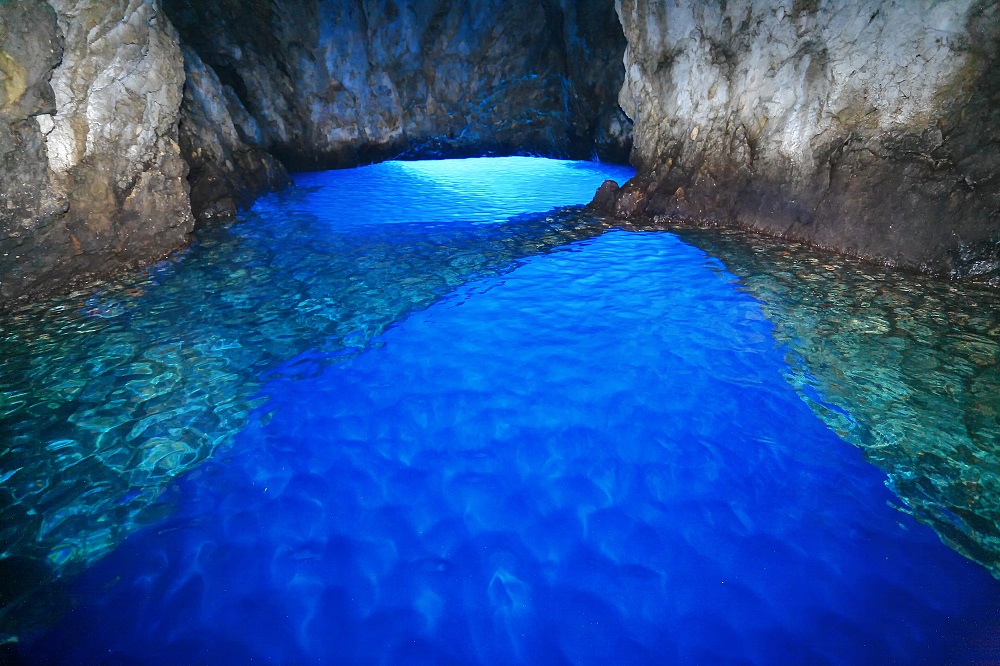
The Monk Seal Cave
The Monk Seal Cave is the longest sea cave in the Adriatic – 160 metres. It is a protected geomorphological monument of nature from 1967. The name comes from the Mediterranean monk seal which once lived here.
Jabuka islet
Rising above the sea like a black pyramid, the island is 30 nautical miles from Komiža, is 97 metres high, and is a protected geomorphological monument of nature from 1958. The island is composed of deep crust magmatic rocks, the magnetite of which interferes with seafarers’ compasses making navigation in conditions of poor visibility extremely difficult when near it. The underwater area is rich in fish and crabs, which is why fishermen from Komiža go to Jabuka in winter and risk their lives going to the island, which has no docks.
Jabuka doesn’t have a natural bay and doesn’t provide shelter from the wind. Anchoring a boat is a difficult task due to the deep sea around the island, and its smooth rocks polished by the sea make it impossible to tie the ship around them. There are as many as twenty toponyms here, and these are the only human traces on this further insular frontier of the eastern Adriatic. The island is made from volcanic diabase rocks and is home to the endemic black karst lizard and two endemic plants.
The Green Cave on the islet of Ravnik
This cave is a protected geomorphological monument of nature from 1967, and the islet itself is a significant landscape. The Green Cave has two large openings to it and it doesn’t give the same type of blue light effect as the Blue Cave, but it's entirely unique because it has a small opening in the middle from where sunlight breaks into the cave and lights up the sea bottom like a spotlight in the darkness. The blackness of this cave enhances the intensity of this miraculous spotlight.

Stiniva bay
Stiniva bay has been classed as a significant landscape since 1967. This narrow and long bay ends with a stone ''gate'' leading into a small cove with a pebble beach surrounded by layered rock walls. Once, Stiniva was a karst cave and it probably collapsed several thousand years ago. In 2016, Stiniva was named the most beautiful beach in Europe.
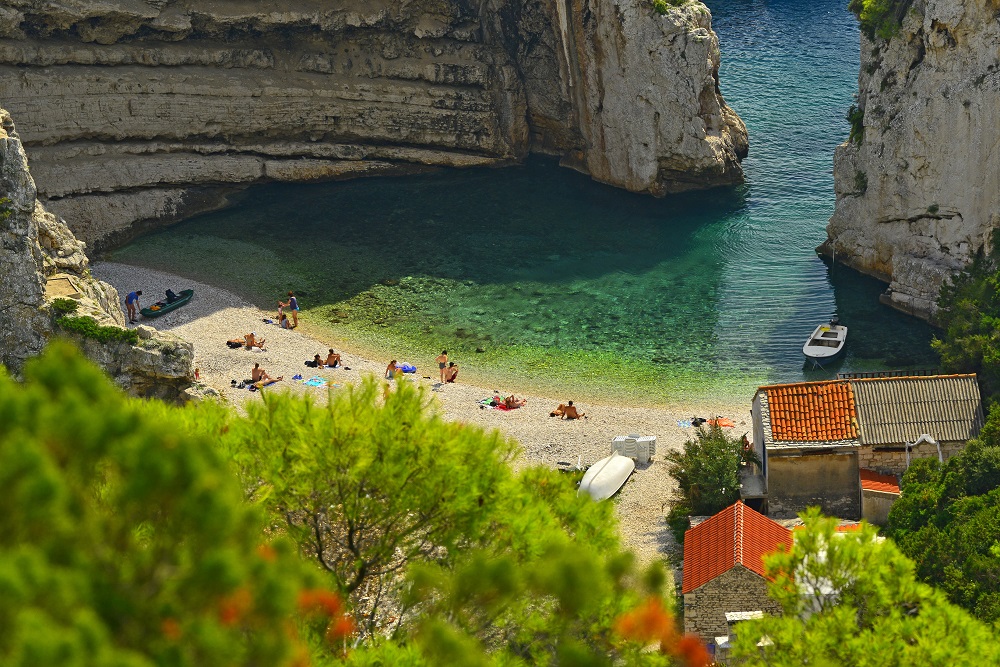
Ravnik islet
Ravnik islet is a significant landscape of nature and is located off the eastern coast of Vis, boasting its green cave.
Brusnik
Brusnik is the protected geomorphological monument of nature and is located thirteen nautical miles from Komiža. Brusnik and Jabuka are the only islands in the Adriatic formed from igneous rocks. It is 23 meters high, and both Brusnik and Jabuka are made of subvolcanic diabase formed by the crystallisation of magma on its way from the deep magmatic core up to the surface. Brusnik island is far more complex than Jabuka, however. Brusnik has paleo beach pebble conglomerates which can be found on the top of the island.
In the middle of the island, there is a ravine with a depression filled with seawater used by fishermen from Komiža, in which they made larger pools to keep their captured lobsters. There are also the remains of fishermens' cottages built from large rocks. These small homes were in use for salting fish in barrels and to keep the fishermen safe from the wind and sun. Brusnik has been a protected area since 1951 and it boasts a special structure – as most of the islands have a limestone base.
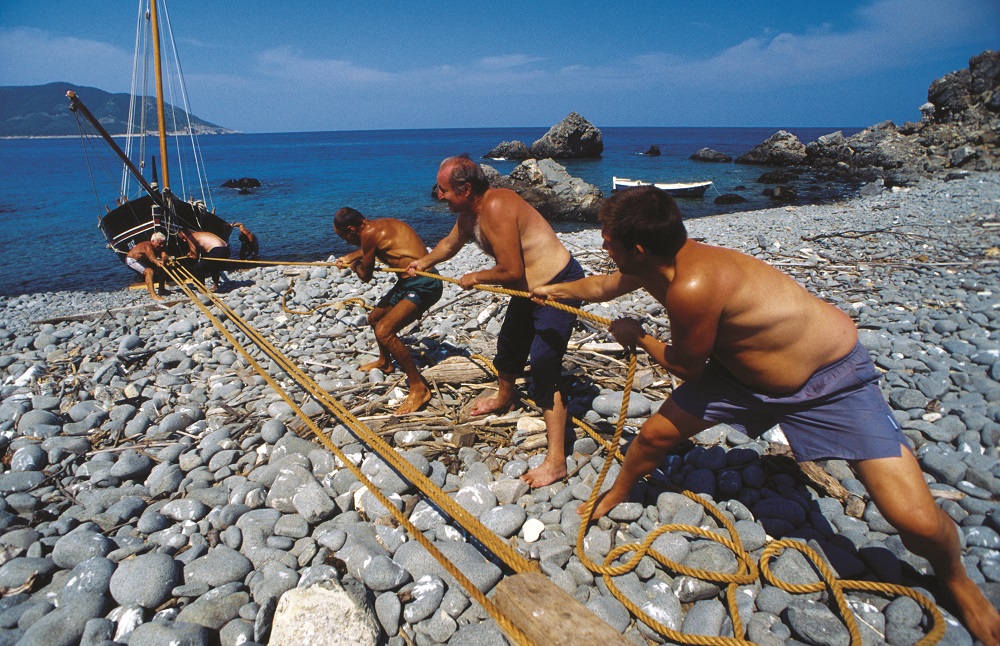
There are several geo-trails in Vis archipelago, here are a few handy links to them:
Geo trail Komiža: https://geopark-vis.com/en/geology/geo-trails
Geo trail Biševo: https://geopark-vis.com/en/geo-trail-bisevo
Geo trail Vis Rukavac: https://geopark-vis.com/en/geostaza-vis-rukavac
A list of geological locations can be found here: https://geopark-vis.com/en/geostaza-vis-rukavac
With this geological area, there are naturally a lot of local traditions and pieces of heritage worth knowing about. Some of the most valuable are Gajeta Falkuša, Suhozid – dry stone walling (another piece of Croatia's intangible UNESCO heritage), The local Vis dialect, Gajeta Falkuša, which is a traditional historical fishing boat. Fishing has been the traditional main occupation of local men from Komiža for centuries. Komiža fishermen are well known as the first to catch fish on the open sea and to face a lot of dangers due to poor weather conditions and pirate attacks.
Local inhabitants lived off the sea and were facing different threats. To fight the open sea and the risks that faced them, fishermen needed to have small and quick boats which could carry a lot in them too. To survive these rough conditions, they made falkuša – a unique traditional fishing boat from Komiža. It is made for fishing, sailing and cargo carrying. The name comes from the word falka, or the sideboards of the ship which enabled the boat to be used for different purposes.
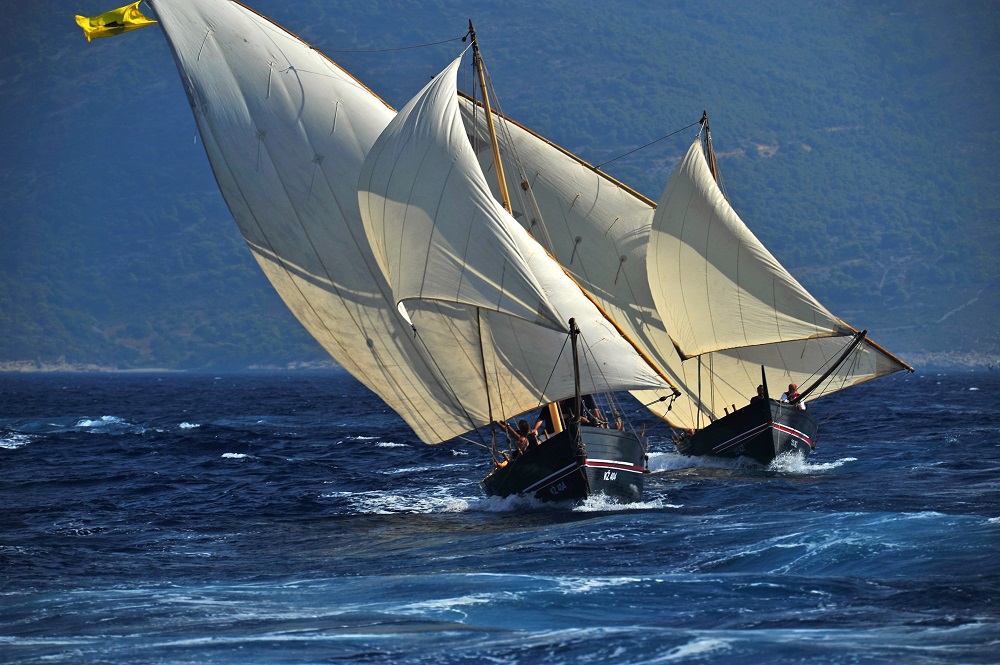
The people of Komiža are proud of Gajeta Falkuša, but it almost disappeared as the storm on Biševo island wrecked the last Gajeta Falkuša named Cicibela.
This terrible damage was repaired by professor Joško Božanić and Velmir Salamon who carried out research on Falkuša for eleven years and all of the aspects essential for this boat, including halieutic, cultural and anthropological interpretation, which included language, lexicon, literature, fishing history, toponymy and anthroponymy, shipbuilding, the art of sailing, traditional weather forecasting, the art of fishing, and even gastronomy.
In 1997 this traditional boat was saved in the form of ''Comeza-Lisboa'', the first falkuša built after many years, as part of the research project of the Cultural Association Ars Halieutica from Komiža. ''Comeza- Lisboa'' was presented at the world expo in Lisbon, Portugal. This launching was a historical moment for Komiža, where old fishing traditions, knowledge and skills were revitalised and presented to locals. Today we have four Gajeta Falkuša boats: Comeza-Lisboa, Mikula, Palagruža and Molo.
Molo is a smaller variant of Falkuša on which children used to learn fishing skills.
Dry stone walling
This piece of UNESCO heritage is an art of its own and is an old tradition which continues to be nurtured on numerous islands and in coastal Croatia, but it's especially interesting on the island of Vis. This type of rural architecture is part of the Vis landscape and has a different form than the rest. The story of dry stone walling is a story about survival, where peasants used their skills in rocky landscapes and securing smaller fertile areas to grow their vineyards and deal with other types of agriculture.
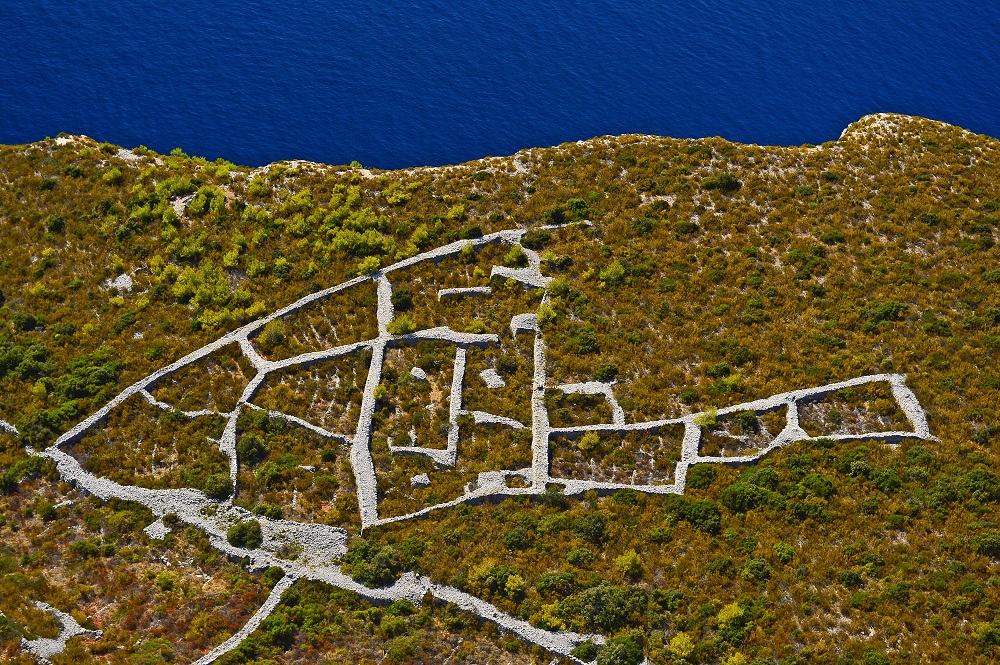
On Vis, the village of Dragodid near Komiža is very well known for its dry stone walling heritage and remains a place for dry stone workshops to this very day.
.jpg)
The Cokavian dialect of Vis
This is another piece of intangible heritage of Croatia and the oldest Slavic dialect in the Eastern Adriatic. It is unique in the fact that it preserves the lexicon from the lingua franca idiom, which is characteristic for the maritime and fishing world. Here is an example of the traditional cokavian dialect of Vis:
U śpȍmen nȍni Juvãni
Śvãku jȕtro
cîn bi źorâ źarudȉla
cîn bi źvȍna źaźvonȉla
ol śnâ bi śe vãrgla
pôk bi źavōpȉla
Ôva Marȉja
śvãki dôn źa pūlnê
kal bi śûnca grûźd śaźrîl
a iź kanpanȅla śe źvûn jōvîl
ol śtolâ bi śe dvȉgla
pôk bi źlãmen
krīźâ ucinȉla
Ôva Marȉja
ondâ jȍpet u śutûn
źajȅcol bi źvûn
a nâ bi pośôl dofinȉla
pôk bi śȅla u kantûn
krȕnicu molȉla
glōvûn obandovãla
kriźȉć buśivãla
i źãrno po źãrno
prȉko pãrśta voltovãla
Ôva Marȉja
i ȍto tãko je nȍna
iś Gūśpûn cavarjãla
trî pūtâ nã don
na plãc źvȍna
molȉtve olpivãla
i da śe nî śvȁ
u molȉtvu pritumbãla
do glũhe źemjê
da nî prĩgla śȉju
śigûr śon
jȍś bi vãvik
naźdrovjãla
Ôvu Marȉju
- Vinko Kalinić (From the collection of songs)
SOURCE(S) (text and photos): UNESCO, Geopark Vis
Find out more about Croatia's incredible UNESCO heritage by following our dedicated lifestyle page.
Go to Visovac Island for Free Between 09:30 and 10:45 on Sundays!
As Poslovni Dnevnik writes on the 23rd of May, 2019, enjoying nature and the peace of the beautiful little island of Visovac is the main motive of the visitors who come here to get away from the hustle and bustle of daily life and to be filled with new energy. The peaceful draw of this island on Visovac Lake, between the Roški slap and the Skradinski buk, is something special indeed.
When it comes to the question of just why this unassuming little pearl of the Krka National Park has always been a place for prayer and reflection, or simply a place to take in the vibrant nature, it's best to seek the answer yourself.
Visovac was first settled by the hermits, more specifically deserters of the Order of St. Augustine, who built a smaller monastery and a small church dedicated to St. The apostle Paul on the island, the Franciscans then arrived on the island after their departure.
Since the mid-fifteenth century, the Franciscan monastery and the Church of Our Lady of Visovac have been located there, which together with the natural landscape itself, make for a truly unique little island. The monastery boasts a valuable archaeological collection, as well as a varied collection of historical objects and a valuable library.
The enchanting nature of Visovac Lake and Krka National Park was quickly recognised and valued by producers, and back in the 1960s, this little island was the ideal place, what with its untouched beauty, to play the location at which the Native Americans once lived, depicted in the adventures of Winnetou. Four years ago, there was yet another new trilogy shot at Visovac.
Boats are sailing to Visovac from Stinica and Remetić.
"On Sunday, visitors to the island will enjoy free transport the boats from Stinica and Remetić, but only when the departures for masses leave (09:30/45, 10:00/15, and 10:30/45, and the boats return immediately after the end of the masses). As for the rest of the days, the boats sail to Visovac at their normal price and with the regular cruise line for Krka NP,'' writes Visovac.hr
The National Park organises excursions by boat from Skradinski buk for which its wise to set aside around two hours. A somewhat longer tour lasts for four hours, and it includes the beauty of Skradinski buk and Roški slap, as well as including Visovac. The prices are from 35 to 130 kuna per person, and children get free tickets up until four years of age, reports PunKufer.
Make sure to follow our dedicated lifestyle page for much more.
New Fast Line to Connect Croatian Islands May be Tourist Hit
The residents of Croatian islands often have rightful complaints about their connections to the mainland not being up to scratch in many cases, and while efforts are being made to create better, more reliable and more frequent connections between Croatia's many inhabited islands and the mainland, many remain less than satisfied.
As Poslovni Dnevnik writes on the 22nd of May, 2019, the carrier of this idea and the launcher of the line itself is the company GV Line Iadera from the Dalmatian city of Zadar which has many years of experience in navigation on important state routes under its belt.
Every single day as of June the 15th to September the 15th, there will be a fast passenger line on the Rijeka-Zadar route and this will also connect the islands of Krk, Rab, and Pag. This is otherwise the first and the quickest fast passenger line to connect Zadar and Rijeka and the islands in this manner, as 24sata reports.
This new line will certainly contribute to not only the ease of the lives of the residents of the aforementioned islands, but also to the overall enrichment of the tourist offer of both Dalmatia and Kvarner respectively, as well as to the better linking of the islands, since the islands of Krk, Rab and Pag have never been connected in such a way with each other, nor have they ever been connected in this way to the Croatian mainland.
Make sure to follow our dedicated travel and lifestyle pages for much more.
Pag Riva Renovated, Reconstruction Stands at 5.8 Million Kuna
A bit of ''cosmetic surgery'' for Pag's main waterfront (riva) as the reconstruction and upgrading of this heavily frequented area gives the town and the island a breath of new life.
As Novac/Jutarnji writes on the 19th of May, 2019, in approximately twenty days, the reconstruction and upgrading of the popular island's main waterfront with a small harbour in the town of Pag, ''Katina'', will finally be completed, and then that part of the coastline in Pag will be ''released'' for general use in its brand new, done up and completely revised edition.
In the reconstruction of Katina harbour, the Zadar Port Authority, with partial support from the Ministry of Maritime Affairs, Transport and Infrastructure headed by Oleg Butković, and Zadar County, invested a massive 5.8 million kuna, and the necessary works were executed by the Zagreb-based company PGP.
The aforementioned works saw the deepening of the bay area in front of Katina, an important coastal wall was properly repaired and two 50 and 80 metre-long pontoons were erected, which resulted in one hundred new berths for boats, according to a report from Zadarski.hr.
At the celebration of the Day of the City of Pag which took place on Friday, the project was presented to the participants of Pag's annual celebration, including to the minister of the competent Ministry, Oleg Butković. Pag riva's new look was presented by Davor Škibola, the director of the Zadar County Port Authority which, as mentioned, was among the investors.
On this occasion, Minister Butković referred to this particular port authority as "the best in Croatia" primarily because of the number of projects it has accomplished or performed in the port areas it manages.
Make sure to stay up to date by following our dedicated lifestyle page for much more.
Click HERE for images of Pag's brand new waterfront by night.
New Fast Connection from Split Airport to Bol Starting on 1 June
Something new is on the cards for the very beginning of next month in time for the height of the tourist season for those wanting a direct line from Split Airport to Bol on the nearby island of Brač, the third largest island in Croatia.
As Morski writes on the 17th of May, 2019, as of the 1st of June 2019 to the 15th of September 2019, the new fast-freight company Adriatic Fast Ferries d.o.o. will introduce a fast-freight line four times a day from Split Airport to Bol on the central Dalmatian island of Brač. There will be two direct connections and two lines which will head to Bol via Split's busy ferry port.
The direct connection will take one hour from Split Airport to Bol, and the line which will stop at Split's ferry port will take an hour and twenty minutes. There will be three lines in place from Bol to Split per day, according to a report from the local portal Bol info.
Unlike for other ferries and connections, tickets for this new line can only be purchased online at the ship's website.
The catamaran for this line was built back in 1999 at the FBM Marine Ltd shipyard and was purchased from the English company Red Jet. The catamaran is 33 metres long and has a capacity of 190 passengers.
Make sure to follow our dedicated lifestyle and travel pages for much more.
First Croatian Avocado Plantation Planted on Island of Vis!
As Morski writes on the 2nd of May, 2019, the very first Croatian avocado plantation has been planted on the Dalmatian island of Vis. The pear-shaped fruit can typically be found growing in Central and South America, it's very rich in vitamins, minerals and other nutrients essential for the health of the organism.
It seems that the warm Mediterranean climate bodes well for the growth of avocados because those growing are advancing well and generally give generous yields. To make the story of the very first Croatian avocado plantation even more unusual, it was kickstarted by two Americans from Wisconsin, the Repanich couple, who, despite their advanced years, have some great business plans under their belts. Perhaps because they eat avocados each and every day.
John and Patricia Repanich, a lively couple in their eighties, replaced life in America with the birthplace of John's grandfather. Back when they lived in the US, they had nut plantations in California, as well as flocks of sheep, and when retirement age came around, out of all of the places in the world, they chose no less than the beautiful island of Vis as their new home, as was reported by HRT. For years and years before that, they'd already spent plenty of time enjoying Vis's stunning Brgujac bay.
''Once a farmer, always a farmer,'' says John. Pensions aren't for rest, it's best to keep your hands busy. Their avocado experiment was fruitful. Ten years ago, they planted their first tree.
When that very first plant ended up ''giving birth'' to hundreds of the avocados, the entrepreneurial American spirit was awakened in Repanich. From Sicily, the couple brought 150 plants to the Croatian island of Vis and started the very first avocado plantation in the whole of Croatia, the first fruit of which is due this autumn.
Avocados otherwise originate from the South and North American rainforests, where, at least according to numerous archaeological discoveries, they were eaten 8,000 years ago. The first avocados were utilised by the Inkas, the Olmecs and Maya peoples, who considered it a magical plant that nourishes the body from the outside and from the inside. It is very rich in good fats, vitamins, minerals, and other nutrients essential to the health of the body.
Among other things, it benefits the heart, reduces blood sugar, helps with arthritis, and even helps people to lose weight. Experts think it is the top food for brain health because of its high share of omega-3 acids and vitamin E.
Avocados are diverse and can be eaten raw or be thermally processed in many ways, and perhaps the most famous avocado dish of all is Mexican guacamole. Thanks to Repanich's, the first Croatian avocados have become an attraction, so more and more people have been coming to Brgujac to see the premier Croatian plantation for themselves. Along with its olive oil and its wine, the island of Vis could easily also become a Croatian island known for its tropical fruits.
Make sure to stay up to date by following our dedicated lifestyle page for much more.
Pag Salt Gains EU Protection - Croatia Now Has 22 Protected Products
As Morski writes on the 11th of April, 2019, Pag salt (Paška sol) has received protection at the EU level. This information has now been published officially and Pag salt has been entered into the register of Protected Geographical Indications (EU PGI), and Pag salt has earned its sought-after protection status throughout the European Union.
"Pag salt'' is sea salt obtained directly from the seawater of Pag bay, its shape that of small cubic crystal structures that are white in colour and contain minerals and trace elements. Most of the crystals are up to 1 mm in size, so 98 percent of all of the salt crystals manage to pass through a sieve with a mesh size of 1.3 mm. It has a concentrated salty taste without any bitterness.
The seawater from the bay of Pag is extremely clean and well-filtered because the bottom of Pag bay, from which it is obtained, is highly rich in shells which act as natural purifiers of the sea, meaning the seawater in that area has very low values of heavy metals, which are at considerably lower levels than the average value of rest of the Mediterranean sea. In addition to that, Pag bay is located far from any areas in which industrial works are carried out, meaning that the sea is even more pure.
Croatia boasts a long and very rich tradition of production and preparation of various agricultural and food products that are characterised by certain special, unique qualities and traditional production methods, and now finally Pag's much loved salt has earned its protection at the highest level.
Although the Republic of Croatia is still the youngest member state of the European Union, it can be extremely proud of itself as it now has 22 different agricultural and food products with names that are now protected at the European Union level, either in the sense of having a protected destination of origin, or having a protected geographical indication. The EU currently has three such schemes which work to protect the names of quality agricultural products and foodstuffs.
Make sure to follow our dedicated lifestyle page for much more.
Sestrunj Shop Job Applied for From Ireland, Germany, America...
We recently reported on an unusual job offer on the island of Sestrunj in the Zadar archipelago. What might appear to many to be a simple job working in a shop has attracted a rather large amount of attention, from Croatia, Europe, and even beyond.
As Poslovni Dnevnik writes on the 8th of April, 2019, there haven't been any schools on the island of Sestrunj for a long time now, and on the island itself, there are only twenty permanent residents.
While Croats tend to move to Ireland in their droves for work opportunities, higher salaries and more job security, Sestrunj, a small island in the Zadar archipelago, has been attracting attention from all sides since the posting of a job offer in a shop on the island, with would-be employees making contact from Ireland, Germany, and even all the way from America, as RTL reports.
Sestrunj - a little island close to Zadar, hasn't even had a shop for four months, and the only the place where you can go and have a drink is at some sort of pensioner's association on the island.
Since Sestrunj has been without a shop for the last four months, supplying the island naturally poses a big problem.
Eventually, the powers that be decided that Sestrunj's store needed to make a return to the island and contacted some commercial chains, and as the first condition for the job, they needed a person who would be willing to move to the island and live there. The interest in the small shop was quite surprising, and so far as many as forty job applications from around the world have arrived on Sestrunj's quiet shores.
"There were mostly people from Slavonia, and there were also people from the United States, Germany, Canada, a gentleman from Ireland called, he was willing to come back to the area," said Nenad Šužberić from Sestrunj.
"They're sick of the crowds in the city, they're probably expecting to come and have some peace on the island and all that," said Sestrunj resident Berislav Fatović.
The shop will need to be done up, but the apartment for the person who will work there is ready.
"It's nice to live here because it's quiet and it's different way of life than in Zadar, in town, but we're missing this shop because you need to think about the most basic necessities in advance, to make sure you've everything you need to have in the house," admitted Zdravka Dilber.
With the re-opening of Sestrunj's shop, everything would be much easier for the island's residents.
Make sure to follow our dedicated lifestyle page for much more.
Cres to Get Cheese Factory Worth More Than Five Million Kuna
The desire is to breathe some life into, and renew the old tradition of island sheep farming on the island of Cres in the Kvarner region through cooperation with local OPGs and cheese factories.
As Marta Duic/Poslovni Dnevnik writes on the 2nd of April, 2019, in the village of Loznati on the beautiful island of Cres on Monday, construction began on the Loznati agricultural cooperative.
As the co-manager Bruno Žic explained, their goal is to restore old fame to island livestock breeding and continue to maintain the tradition of sheep farming that has been present on the island of Cres for a great many years.
"In the seventies during the last century, this place had a cheese factory and we decided to make our contribution to the preservation of that tradition. The Loznati agricultural cooperative is a small family cooperative, we have seven members and we're open to cooperate with small OPGs and cheese producers. Our desire is to bring as many people back to sheep farming as we can, we're very ambitious and we will try to restore the former numbers,'' stated Žic.
As he claims, the capacity is 500 litres of milk per shift, ie an impressive 1000 litres per day, and the value of the investment stands at 5.600.000 kuna.
"Of the total investment, two million kuna is non-refundable because we have secured it through EU funds, and the remainder is partly our money and partly from an HBOR loan," added Žic.
When construction works are completed, the Cres site will occupy a total area of 540 square metres.
Agriculture Minister Tomislav Tolušić was present at the opening ceremony on Cres.
The Faculty of Agriculture in Zagreb has dealt with the technology for us, and on that basis we started to realise the whole project and the [involved] works. The HACCP standards required in production will be implemented here with us, and the cheese factory itself will be a combination of modern and traditional. We tried not to ruin the looks of the village,'' concluded Žic.
Make sure to follow our dedicated business page for much more.
Click here for the original article by Marta Duic for Poslovni Dnevnik


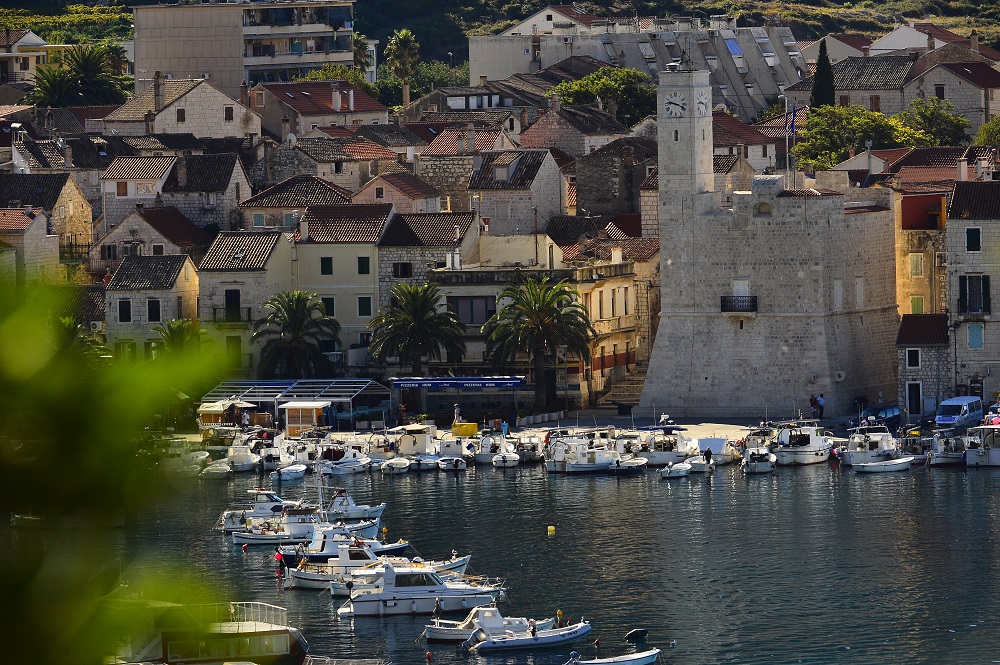


.JPG)
